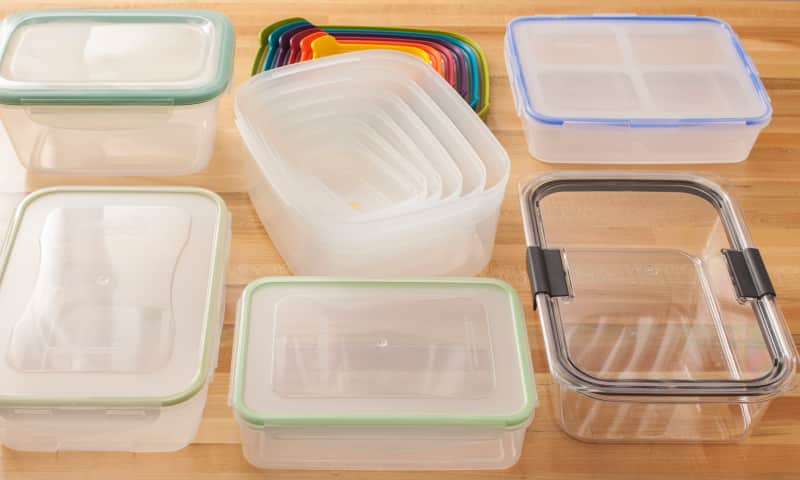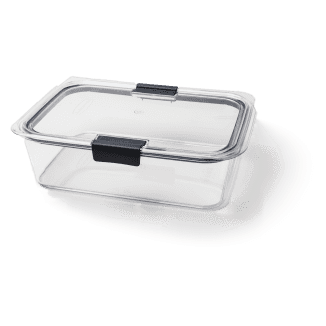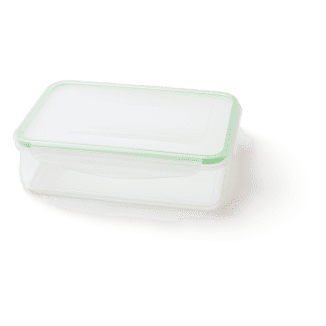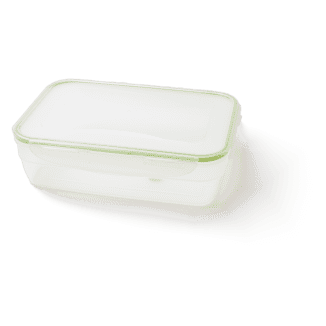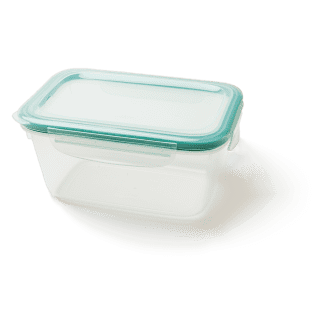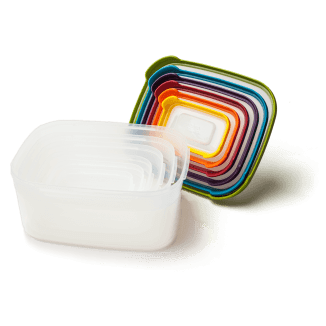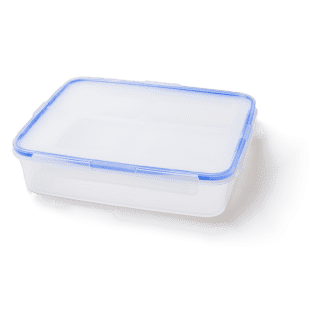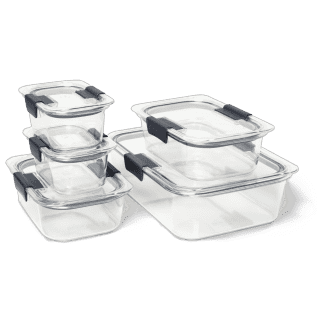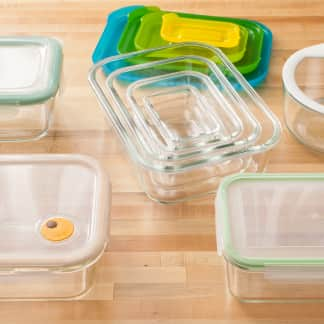Whether you're storing leftovers, preparing a make-ahead meal, or taking lunch to work, you need a food storage container to keep food fresh, intact, and ready to eat. But the containers most of us have at home are pathetic: a motley pile of warped, stained bottoms and cracked, mismatched lids. Stores are brimming with containers claiming to be leakproof, airtight, microwave-safe, and more, but which ones actually function as promised—and, more important, hold up to serious use over time? You could keep repurposing that old yogurt container, but maybe it's time to trade up.
In our last testing, we chose the Snapware Airtight 8 Cup Rectangular Container as our favorite plastic model, but we've heard complaints about the performance of recently purchased copies; plus, new competitors have emerged. We like having both plastic and glass containers on hand, since each has advantages: Plastic is light and less fragile, whereas heavier glass won't warp and resists stains. Many glass containers are also ovensafe.
We decided to test both, so we bought six plastic containers, including our former winner, and five glass containers (read our review of glass containers here) to find out which functioned best without warping, staining, shattering, and/or failing to keep a tight seal. We didn't include disposable supermarket versions, which are great for occasions when you don't need the container returned but aren't designed for durability.
Why Airtight, Leakproof Containers Are Important
We've all tucked a container of lunch into a tote or backpack only to discover later that it has dripped all over the inside of the bag. The products in our lineup made plenty of promises to be leakproof and/or airtight. To check, we filled each container with 2 cups of water tinted with food coloring to make drips easy to spot and then shook them hard in all directions over white paper towels for 15 seconds. One didn't last 5 seconds before the lid opened and water gushed out. Two—including our former winner—allowed a steady, thin stream or a few drops to escape, but three containers kept the towels dry, meaning we might take them to a potluck, use smaller versions to pack lunch, or let them tip a bit in a crowded refrigerator without unpleasant surprises.

To test if the containers were truly airtight, we sealed a spoonful of moisture-detecting crystals in each and then submerged them in water for 2 minutes. These crystals change from blue to pink if the slightest moisture reaches them. A few of the containers kept the crystals uniformly blue, indicating that the interior stayed dry as a bone. But some containers instantly began filling with water, washing out the experiment; others revealed a smattering of pink crystals among the blue when we opened them, demonstrating that a small amount of moisture had entered. If moisture can penetrate, so can air, which lets food become stale. At the same time, any odors from the food might not stay in the container and could spread through your refrigerator.

Containers That Won't Smell or Stain
The most leakproof container is still a poor choice if it's hard to keep clean and odor-free. Most containers are designed similarly: a box and lid fitted with a silicone gasket for a tight seal and flaps or extended rims that snap down to hold the lid in place. The problem is, gaskets and lid hardware can trap food, moisture, and odors. We filled the containers with pungent oil-packed tuna and anchovies, refrigerated them overnight, and then removed the fish and ran the containers through the dishwasher. Staffers sniffed the clean containers, noting any lingering fishy odors. The bad news: Most did trap smells and oily residue around their gaskets. But some gaskets were much easier to clean than others. Our front-runner's was not stuffed into the usual narrow channel but simply built into the lid so you could clean under it; another model had a big, soft, ⅜-inch-wide square gasket that was very easy to remove and replace in a channel broad enough for a cloth-covered fingertip to dry it thoroughly.
Staining is the plague of plastic containers. They might still function, but they look terrible. We stored chili full of tomatoes and colorful spices in the containers over a weekend. We then microwaved them until the chili hit 160 degrees, a piping-hot serving temperature. (Note: We no longer recommend microwaving any plastic container, as it poses a health risk. For more information, see the FAQ “Is it safe to microwave plastic food storage containers?”) After we ran them through the dishwasher, the containers still sealed easily, but most were deeply stained. The type of plastic determined the outcome: Five of the six containers were made of polypropylene and kept that familiar cloudy-orange tint. The sixth, made of a clear plastic called Tritan, stayed stain-free.

Which Containers Were Most Durable?
A container that works for only a few months is a waste of money. If the gasket breaks, there goes the seal. If the lid and flaps warp, you're stuck playing Whack-A-Mole to keep it closed. After our first microwave test, even before the container went into the dishwasher, the gasket on our former top-rated plastic container darkened from blue to black and broke, leaving a small gap in the channel where the gasket had split and shrunk. (Since our last testing, the manufacturer was sold, which may have affected production methods.)
With just weeks to assess long-term durability, we subjected all the containers to abuse testing: We opened and closed each one 100 times. Next we ran them through 50 dishwasher cycles, simulating a year of use. Then we repeated every previous test: shaking and submerging, storing fish and checking odors, storing and heating chili, and opening and closing lids 100 times. Finally, we filled the containers with water and knocked them off the kitchen counter and then froze water in them and dropped them onto the floor. Some containers burst open and one container's protruding corner tab (to help open the lid) snapped off, but three models stayed intact and watertight. You might never drop your container, but knowing that it is unlikely to pop open and make a mess gives you peace of mind.

The Best Plastic Food Storage Container
After container boot camp, we had a winner: the Rubbermaid Brilliance Food Storage Container, Large, 9.6 Cup. We loved its roomy, flat shape that was easy to stack and helped food heat faster and more evenly than in deeper containers. We appreciated that its gasket was attached to the lid for cleaning without the fuss of removing a slippery bit of silicone, and we liked its pair of lid clips that doubled down on its already-tight seal. An extended rim on this container stayed cool for easy handling when food was hot. Best of all, it didn't leak, and it emerged from extensive testing still looking clear, clean, and good as new. While we tested the 9.6-cup container, Rubbermaid offers a variety of sizes in this line.
The Tests
- Fill container with 2 cups water tinted blue with food coloring and shake (in all directions, inverting completely) over white paper towels for 15 seconds, checking for leaks.
- Place 1 tablespoon Indicating Drierite moisture-detecting crystals in container and submerge in large bucket of water for 2 minutes. Dry exterior carefully, open, and check for crystals that changed color, indicating that moisture has entered.
- Fill with 1 can each oil-packed tuna and anchovies, seal, and refrigerate overnight. Remove fish, wash container in dishwasher, and have testers sniff for residual fish odors.
- Fill with Simple Beef and Bean Chili, noting amount that fits; store in refrigerator over a weekend. Heat in microwave until chili is uniformly 160 degrees, a piping-hot serving temperature. Remove chili, wash containers in dishwasher, and examine for damage to lid and seal, as well as stains and odors.
- Fully open and close lid 100 times, reversing direction of lid each time.
- Run containers through 50 dishwasher cycles. Examine for damage, warping, and staining.
- Repeat all previous tests to see if dishwashing and previous use have affected performance.
- Fill container with water and push off kitchen counter, noting any leaks or damage.
- Freeze water in container and drop from 3 feet above kitchen floor, noting any brittleness or damage.
How We Rated
- Leaks: We filled the containers with water tinted with blue food coloring and shook them vigorously for 15 seconds. We also filled them with moisture-detecting color-changing crystals and submerged them in water for 2 minutes. Containers that didn't leak when shaken and that kept their contents dry when submerged received high marks.
- Odors: We refrigerated oil-packed tuna and anchovies in each container overnight and ran the containers through a home dishwasher and checked for odors. Containers that resisted odors and cleaned up more easily were preferred.
- Design: We considered features that made the containers easier to use, including simple, intuitive seals and shapes that stack well and make cooling and heating more efficient.
- Storage and Microwave Heating: We filled containers with chili, refrigerated them over a weekend, and microwaved them, checking for warping, staining, and other damage. Containers that didn't leak or spill, held plenty of chili, and resisted warping, staining, and other damage rated highest.
- Durability: We opened and closed each container 100 times, washed the containers 50 times in a home dishwasher, and repeated all the previous tests (leaking, odors, opening and closing, microwaving). Then we filled containers with water and knocked them off a kitchen counter and froze water in them and dropped them from 3 feet above the floor. Finally, we checked for stains, warping, breakage, and general wear and tear, giving high marks to those still in good condition.
- Airtight and leakproof
- Made of transparent, stain-resistant, tough Tritan plastic
- Generous 9.6-cup size
- Shallow, rectangular shape that helps food chill and heat more uniformly
- A level, flat top that makes it easy to stack other objects on top in the fridge or freezer
- Clips that help secure the lid and open to reveal small vents to permit microwaving with the lid on, reducing splatter
- Extended rims that stay cool and assist in handling when the container is hot
- Attached silicone gasket that doesn't require removing and replacing during cleaning
- Safe for use in dishwasher, freezer, and microwave
